How to Clean Artificial Plants
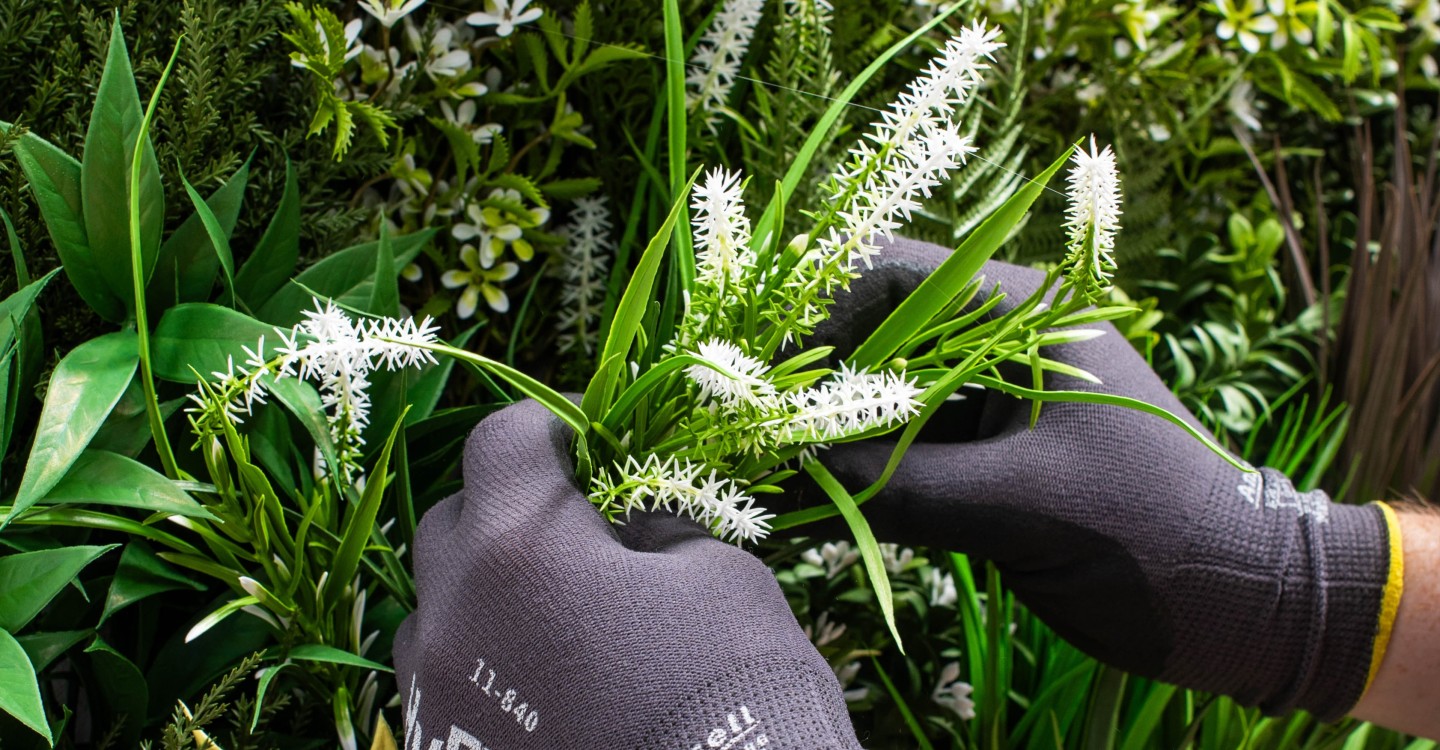
How to Clean Artificial Plants
Artificial plants bring lasting beauty to any space, but without proper maintenance, even the most realistic arrangements can become a dusty eyesore. Whether you’re dealing with silk or leafy greenery, knowing how to get your artificial plants clean can extend their lifespan and keep them looking fresh for years.
Many people avoid cleaning their artificial trees and plants because they’re unsure which methods will not damage delicate leaves or cause colours to fade. The reality is that cleaning fake plants requires a tailored approach based on the specific material composition. This comprehensive guide will walk you through every cleaning method, from quick dusting techniques to deep cleaning processes, ensuring your artificial greenery maintains its vibrant appearance.
Identify Your Plant Material
Before beginning any cleaning process, take time to examine your plants carefully. Different materials require different approaches, and using the wrong method can cause permanent damage.
Start by looking closely at the leaves, stems, and any other decorative components. Silk flowers, for example, typically have a soft, lustrous appearance with natural-feeling texture variations. Plastic leaves often have a more uniform surface and may feel slightly rigid. Fabric components fall somewhere between these extremes, usually featuring realistic textures but maintaining some flexibility.
Check for delicate components, such as natural trunks, wire stems, or intricate leaf details. These elements often require special consideration during cleaning. Natural wood components can absorb water and deteriorate, while wire stems may rust if exposed to excessive moisture.
Note any special finishes or coatings that might be damaged by water. For example, UV-resistant coatings, or our realistic “real-touch” flower petals, can be particularly vulnerable to aggressive cleaning methods or harsh chemicals.
Consider the age and quality of your fake plants before cleaning. Older faux plants may have weakened adhesives that could fail during cleaning, while newer, higher-quality pieces can typically withstand a more rigorous scrub. It’s also important to take photos of your plants before disassembly, to help you recreate the original setup after cleaning.
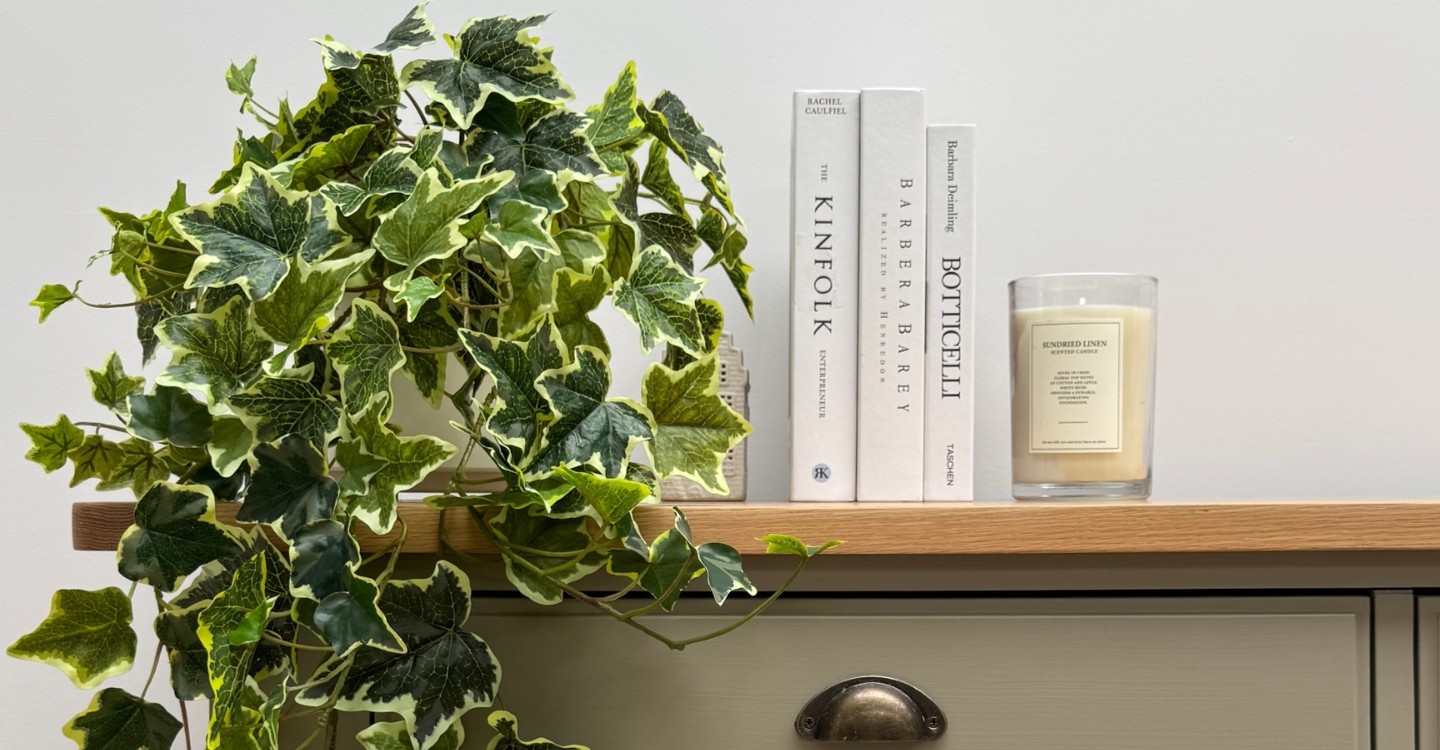
Dusting and Dry Cleaning Methods
Dry cleaning methods form the foundation of faux plant maintenance and should be your first line of defence against dust accumulation. These techniques preserve delicate finishes while effectively removing surface dirt and debris.
Use microfibre cloths to gently wipe each petal or leaf, starting from the top of your arrangement and working downward. This prevents you from redistributing dust onto areas you’ve already cleaned. Microfibre is particularly effective because its fine fibres trap dust particles rather than simply moving them around.
Use a soft-bristled paintbrush for detailed cleaning of small crevices and intricate areas. Small brushes work exceptionally well for reaching between layers of petals or cleaning detailed foliage. This method is especially valuable for high-quality silk plants with complex structures.
Work systematically from top to bottom to prevent re-dusting cleaned areas. This approach ensures maximum efficiency and prevents you from having to clean the same sections multiple times. Pay special attention to the undersides of leaves and the centres of flowers, where dust tends to accumulate most heavily.
Shake the plant gently outdoors to remove loose dust before beginning detailed cleaning. This preliminary step removes the majority of surface dust and makes your subsequent cleaning efforts more effective. Always perform this step outside to avoid spreading dust throughout your house.
Using Compressed Air and Hair Dryers
Compressed air and hair dryers offer powerful solutions for removing dust from fake plants without physical contact. These methods work particularly well for plants with intricate details that are difficult to reach with cloths or brushes, or those with an overwhelming number of leaves.
Set your hair dryer to the cool setting to avoid heat damage to foliage, adhesives, or special finishes. Heat can cause plastic leaves to warp, silk to fade, or adhesives to weaken. The cool air setting provides adequate force to dislodge dust without risking thermal damage.
Hold the dryer 6-8 inches away from flowers to prevent excessive force that might damage delicate components or blow leaves out of position. This distance provides optimal cleaning power while maintaining safety for your plants.
Use compressed air for hard-to-reach areas. Compressed air cans provide controlled bursts of air that can reach areas impossible to access with other cleaning tools. The precision of compressed air makes it ideal for detailed work on complex products.
Perform this method outdoors or near open windows to avoid redistributing dust throughout your indoor space. The whole point of cleaning is to remove dust from your environment, not simply relocate it to other surfaces in your home.
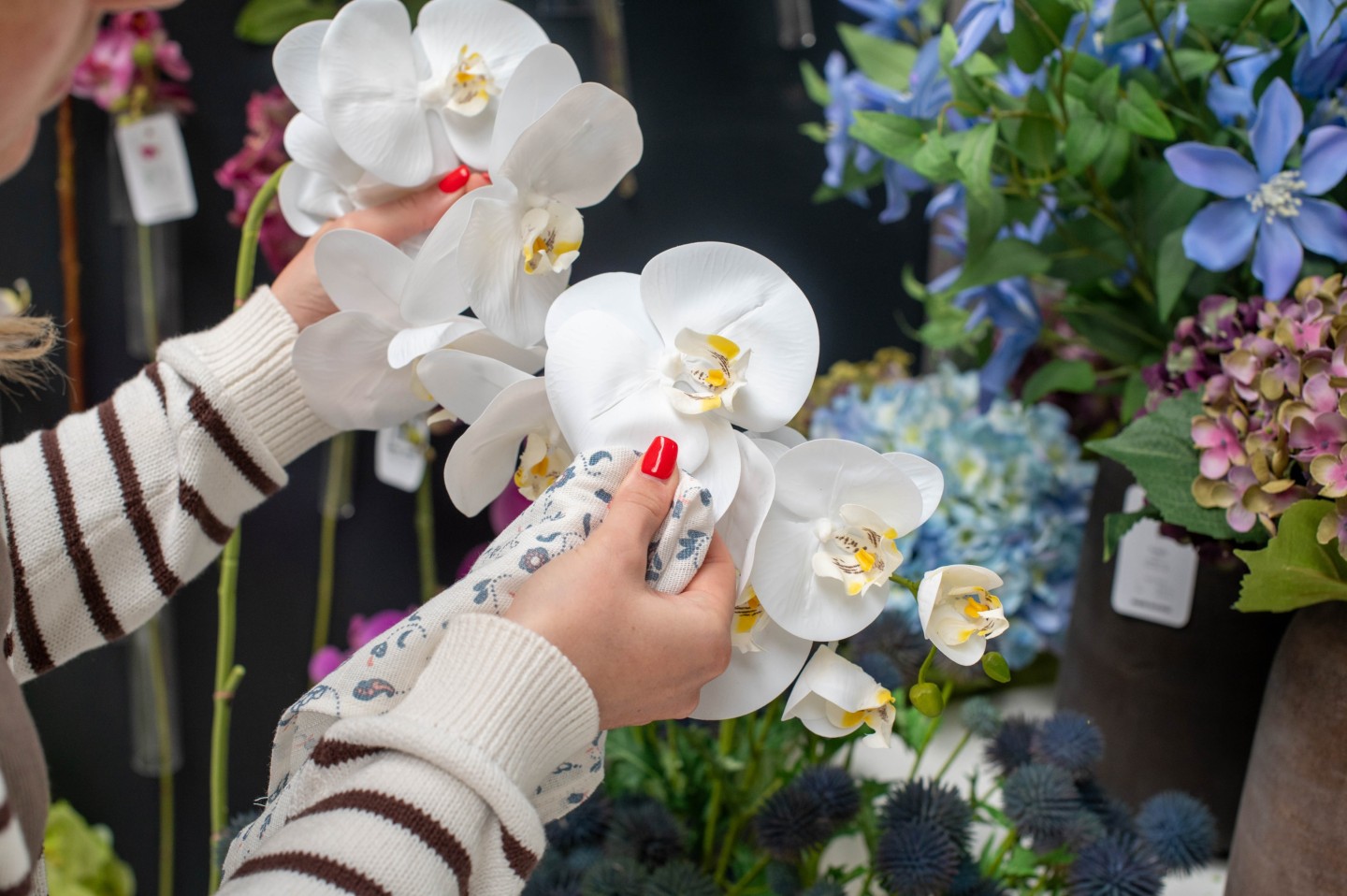
Wet Cleaning Techniques
When dry cleaning methods aren’t sufficient to restore your plants, wet cleaning techniques can provide deeper cleaning results. However, these methods require careful consideration of your plant materials and construction to avoid damage.
Always test your chosen cleaning method on a hidden area first. This critical step allows you to identify potential problems like colour bleeding, adhesive failure, or material damage before they affect visible portions of your plants.
Use the damp cloth method for plastic and latex materials only. These typically handle moisture well and can be cleaned with slightly dampened microfibre cloths. Avoid saturating the cloth; it should be barely damp to prevent excess water from reaching adhesives or delicate components.
Rinse sturdy faux plants under cool water for more thorough cleaning. This direct approach works well for high-quality plastic plants and some fabric varieties, but requires careful attention to drying afterwards. Always use cool or lukewarm water to prevent heat damage.
Avoid soaking delicate silk or fabric flowers, or plants that contain natural wood elements, as prolonged water exposure can cause colours to fade, adhesives to fail, or materials to deform. These premium materials require gentler approaches that preserve their realistic appearance and texture.
Soap and Water Method
For plants that can tolerate water exposure, the soap and water method provides thorough cleaning that removes embedded dirt and stubborn residue.
Mix mild soap with cool water for plastic plants, using just a few drops of mild soap per cup of water. Harsh detergents can damage finishes or cause colours to fade, so stick with gentle, pH-neutral options.
Submerge only the leaves when possible, keeping stems dry to protect internal wire structures and prevent rust formation. Many plants contain metal wires that can corrode when exposed to moisture, potentially weakening the entire structure.
Gently rub leaves and petals between your fingers to remove stubborn dirt or sticky residue. This technique is particularly effective for removing accumulated grime from plants displayed in kitchens or other areas prone to airborne grease or residue.
Rinse thoroughly with cool water to remove all soap residue, which can attract dirt if left on the plants. Incomplete rinsing can actually make your plants dirtier faster, defeating the purpose of cleaning them in the first place.
Cleaning Spray Application
Commercial faux plant cleaning sprays offer a convenient middle ground between dry dusting and full water washing. These products are specifically formulated to clean artificial materials without causing damage.
Purchase a spray designed specifically for plants rather than general-purpose cleaners. Generic household cleaners may contain chemicals that dissolve adhesives, fade colours, or damage special finishes on high-quality plants.
Test the spray on an inconspicuous area first to check for colour bleeding or adverse reactions. Even products designed for plants can occasionally react unexpectedly with specific materials or finishes.
Apply spray outdoors or protect surrounding surfaces from overspray. Many cleaning sprays can stain furniture, walls, or flooring if accidentally applied to these surfaces during the cleaning process.
Allow your plants to air dry completely without rinsing, unless product instructions specify otherwise. Most plant cleaning sprays are designed to evaporate completely, leaving behind clean foliage without residue.
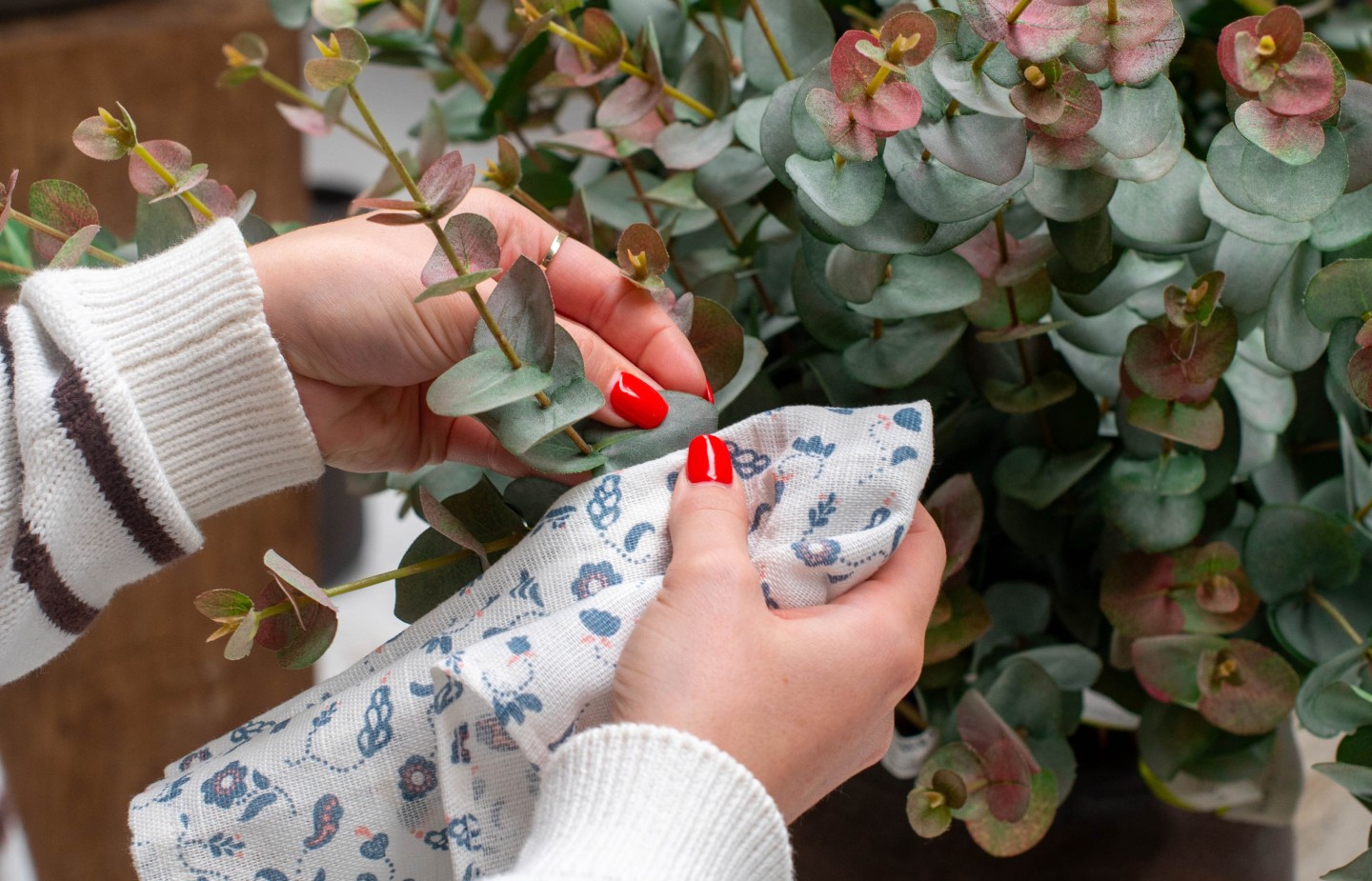
Cleaning Different Artificial Flower Types
Premium artificial flowers, especially those with a “real-touch” texture, require careful handling to maintain their finish. Knowing the materials used in each flower helps you select the most effective cleaning method for every type in your collection.
Clean silk flowers with extra care to prevent colour running or fabric damage. Silk artificial flowers often feature delicate dyes that can bleed when exposed to moisture, and the fabric itself can lose its lustre if treated too aggressively. Stick to dry cleaning methods whenever possible for these premium artificial plants.
Clean plastic flowers more aggressively with water methods, as these materials typically withstand moisture and gentle scrubbing without damage. Plastic artificial flowers are often the most durable option and can handle thorough cleaning that would damage more delicate materials.
Use dry methods only for fabric flowers with special finishes, such as flocked surfaces or realistic textures. These finishes can be permanently damaged by water or cleaning chemicals, making dry dusting and compressed air your only safe options.
Treat “real-touch” flowers like delicate silk varieties, as their specialised surface treatments can be easily damaged. These premium artificial flowers feature coatings that create incredibly realistic textures, but these same coatings are vulnerable to aggressive cleaning methods.
Drying and Post-Cleaning Care
Proper drying techniques are crucial for preventing mould, mildew, and structural damage after wet cleaning your artificial plants. Taking time to dry the plants correctly protects your investment and ensures long-lasting beauty.
Shake excess water gently after wet cleaning to remove surface moisture without damaging delicate components or loosening adhesives. Vigorous shaking can cause leaves to detach or stems to bend, so use gentle motions that encourage water to drip off naturally.
Allow 2-4 hours of drying time in a well-ventilated area before returning the plants to their display locations. Rushing the drying process can trap moisture that leads to mould or mildew formation, especially in areas with limited air circulation.
Reshape leaves and stems while they’re slightly damp if needed, as this is when materials are most pliable. Once completely dry, artificial plants become more rigid and difficult to adjust, so take advantage of this window to perfect your plant’s appearance.

Spot Cleaning Tips and Stain Removal
When your artificial plants have localised stains or stuck-on dirt that general cleaning hasn’t addressed, targeted spot cleaning techniques can restore their appearance without subjecting the entire piece to intensive cleaning.
Mix white vinegar with water in a 1:2 ratio for stubborn stains that resist normal cleaning methods. This natural solution effectively breaks down many types of stains without the harsh chemicals that could damage artificial plant materials.
Apply diluted laundry detergent directly to specific spots using a cotton swab or small brush for precise application. This targeted approach minimises exposure of undamaged areas to potentially harsh cleaning agents while focusing treatment where it’s needed most.
Rinse thoroughly after spot treatment to prevent residue buildup that could attract future dirt or cause discolouration. Even gentle cleaning agents can cause problems if left on artificial plants, so complete removal is essential for long-term product health.
Use baking soda overnight for persistent odours that cleaning hasn’t eliminated. Sprinkle a small amount of baking soda on affected areas, allow it to sit overnight to absorb odours, then brush or vacuum away the powder the next day.
What to Avoid When Cleaning Artificial Plants
Understanding what not to do when cleaning artificial plants is just as important as knowing proper techniques. Avoiding these common mistakes protects your artificial plants from irreversible damage and extends their useful life.
Never use hot water, which can damage adhesives holding leaves in place, cause colours to fade, or warp plastic components. Hot water can also cause silk fibres to shrink or lose their lustrous appearance, permanently diminishing the quality of your artificial plants.
Avoid harsh chemicals and bleach that dissolve binding agents or cause colour changes. These aggressive cleaners may seem like they would provide superior cleaning power, but they often cause more damage than benefit when used on artificial plants.
Don’t put artificial plants in dishwashers or washing machines, regardless of material type. The aggressive water action, high temperatures, and harsh detergents used in these appliances will almost certainly damage artificial plants beyond repair.
Prevent over-wetting of delicate materials, natural wood elements, and foam components, which can absorb water and never fully dry, leading to mould and structural failure.
Maintenance Schedule and Prevention
Establishing a regular maintenance routine prevents heavy soil buildup and extends the time between deep cleaning sessions. Consistent care is far easier than attempting to restore heavily soiled artificial plants.
Dust artificial plants weekly in high-traffic areas where they’re exposed to more airborne particles. Regular dusting prevents the accumulation that makes deep cleaning necessary and keeps your artificial greenery looking fresh and vibrant.
Perform deep cleaning quarterly or when plants become visibly dirty, depending on your home’s dust levels and the location of your greenery. Plants near windows, heating vents, or in kitchens may require more frequent attention than those in protected locations.
Spray with diluted white vinegar monthly to prevent musty odours from developing in fabric or silk artificial plants. This preventive measure is particularly important in humid climates or homes without optimal air circulation.
Store artificial greenery in dust-free boxes when not displayed to minimise cleaning requirements and protect them from damage. Proper storage dramatically reduces maintenance needs and helps preserve the quality of your artificial plants for future use.
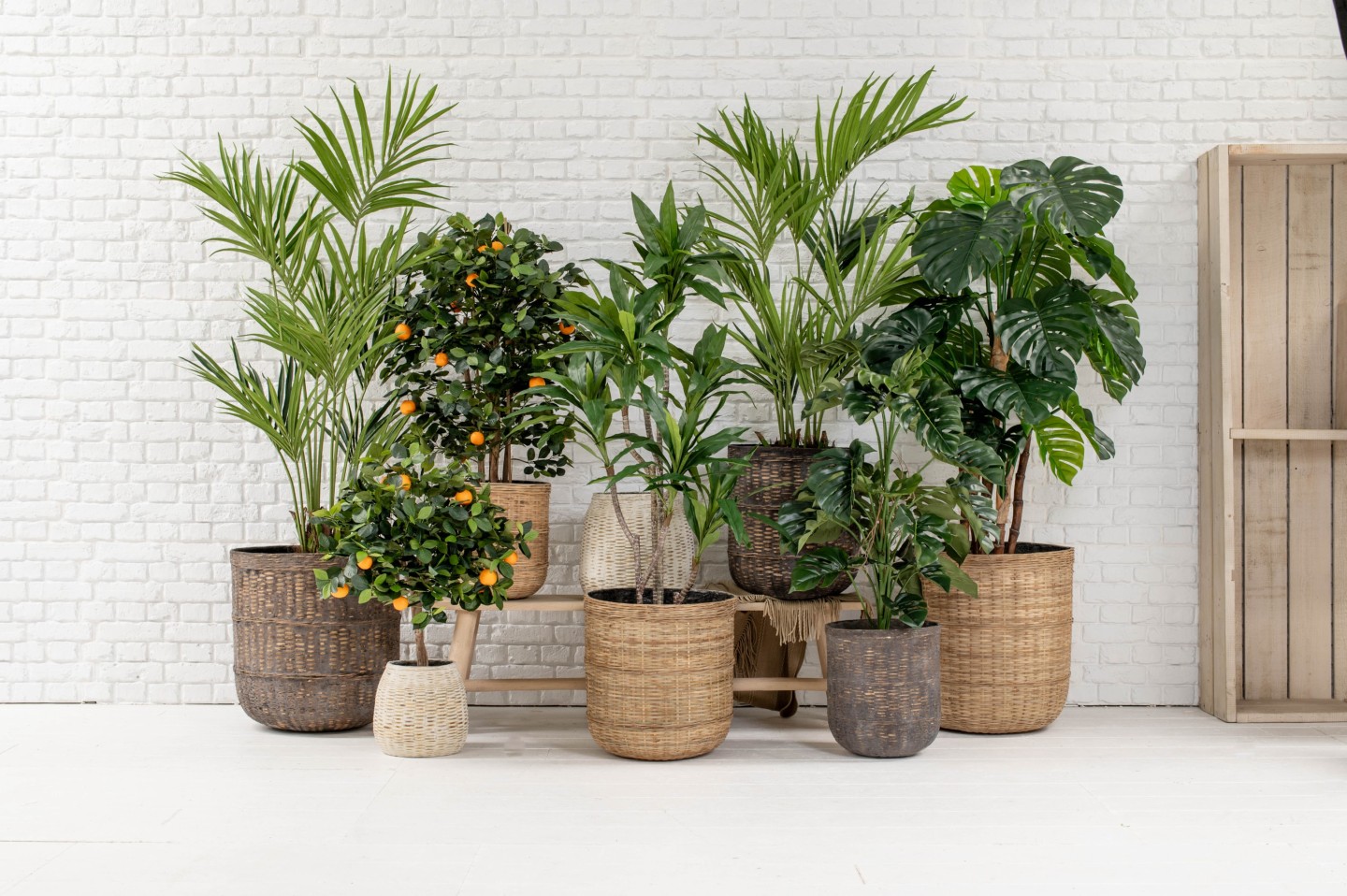
Repair and Reshaping After Cleaning
Cleaning sometimes reveals damage that wasn’t visible under layers of dust, or the cleaning process itself may cause minor issues that need attention. Addressing these problems promptly maintains the overall quality of your artificial plant arrangements.
Reattach loose leaves or stems with clear craft glue designed for the specific material of your artificial plants. Use sparingly to avoid visible glue marks, and ensure the adhesive is completely dry before handling or displaying the repaired plants.
Use a hair dryer on a cool setting to reshape bent leaves or petals that may have been deformed during cleaning or storage. The gentle heat and airflow can help restore the original shape of many artificial plant components without causing damage.
Trim damaged stems that cannot be repaired to maintain the overall appearance of your plant. Sometimes it’s better to remove severely damaged elements rather than allow them to detract from the beauty of those remaining.
Reference your photos taken before cleaning to recreate the original arrangement if you disassembled it for thorough cleaning. This documentation proves invaluable for restoring complex arrangements to their intended appearance.
Learning how to clean artificial flowers and plants properly transforms them from dust collectors into lasting decorative elements that enhance your space year after year. Whether you’re dealing with silk, plastic, or mixed-material plants, the right cleaning approach preserves their beauty while extending their useful life.
Remember that the best method for cleaning artificial plants depends entirely on the specific materials and construction of each plant. Start with the gentlest techniques and progress to more intensive cleaning only when necessary. Regular maintenance prevents the need for aggressive cleaning methods that risk damaging your investment.
With proper care and the techniques outlined in this guide, your artificial low-maintenance greenery will continue to provide the beauty of natural plants without the maintenance requirements, giving you lasting enjoyment of your decorative arrangements.



